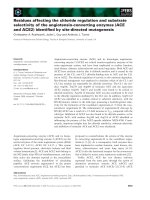The only ekg book youll ever need 5th ed by mik
Bạn đang xem bản rút gọn của tài liệu. Xem và tải ngay bản đầy đủ của tài liệu tại đây (12.03 MB, 251 trang )
Authors: Thaler, Malcolm S.
Title: Only EK G Book You'll Ever Need, The, 5th Edition
Copyright ©200 7 Lippincott Williams & Wilkins
> F r o nt o f Bo o k > Aut ho r s
Author
Malcolm S. Thaler M.D .
Attending Physician
The Bryn Mawr Hospital, Bryn Mawr, Pennsylvania
Secondary Editor
Sonya Seigafuse
Acquisitions Editor
Nancy Winter
Managing Editor
Kimberly Schonberger
Marketing Manager
Bridgett Dougherty
Project Manager
Benjamin Rivera
Senior Manufacturing Manager
Risa Clow
Design Coordinator
Production Service
GGS Book Services
R. R. Donnelley, Crawfordsville
Printer
Authors: Thaler, Malcolm S.
Title: Only EK G Book You'll Ever Need, The, 5th Edition
Copyright ©200 7 Lippincott Williams & Wilkins
> F r o nt o f Bo o k > D e d i c a t i o n
Dedication
For my mother, who will always live in my heart, and for Nancy, Ali, and Jon,
still and always the heart of m y matter.
Authors: Thaler, Malcolm S.
Title: Only EK G Book You'll Ever Need, The, 5th Edition
Copyright ©200 7 Lippincott Williams & Wilkins
> F r o nt o f Bo o k > Pr e fa c e
Preface
Preface
It seems incredible that, in a world where new technology becomes obsolete
almost before it becomes available, a simple little electrical gizm o, more than a
century old, still holds the key to diagnosing so many critically important
clinical disorders, from m ild palpitations and diz ziness to life-threatening heart
attacks and arrhythmias. The EKG predates relativity, quantum mechanics,
molecular genetics, bebop, Watergate, and, well, you fill in the blank. H ats off,
then, to Willem Einthoven and his string galvanometer with which, in 19 05, he
recorded the first elektrokardiogramm.
So here we are, well into the next m illennium , and now it is your turn to learn
how to use this amazing tool. It is my hope that this little book (itself getting a
bit long in the tooth, having first come out in 1988 ) will make the process fun
and easy. Its goals remain the sam e as they did in the first edition:
This book is about learning. It's about keeping simple things simple and
complicated things clear, concise, and yes, sim ple, too. It's about getting from
here to there without scaring you to death, boring you to tears, or intim idating
your socks off. It's about turning ignorance into knowledge, knowledge into
wisdom , and all with a bit of fun.
There is a lot of new stuff in this fifth edition. We have, among other things,
updated the sections on basic electrophysiology, rhythm disturbances, and
pacemakers, and included many new sample EK Gs at the end of the text so you
can test your new, hard-won knowledge.
Again I must thank Glenn Harper, M.D., not only one of the world's great
cardiologists, but also one of its really good guys, for reviewing this book and
making sure it is accurate and up to date. To all the folks at Lippincott Williams
& Wilkins, thanks for once m ore producing a beautiful and readable text and
making the whole process of revising it so sim ple and enjoyable.
And to you readers, I hope that The Only EKG Book Y ou'll Ever Need will once
again give you everything you need—no more and no less—to read EKGs
quickly and accurately.
Malcolm Thaler
Authors:
Title:
Thaler, Malcolm S.
Only EKG Book You'll Ever Need, The, 5th Edition
Copyri ght ©2007 Li ppi ncott Wil l i ams & Wil ki ns
> T a bl e of Co nt e nt s > Ge t ti n g S t ar t ed
Getting Started
P.2
P.3
On the opposi te page i s a normal el ectrocardiogram, or EKG. By the ti me you have
fi ni shed thi s book—and i t won't take very much ti me at al l —you wil l be abl e to
recogni ze a normal EKG al most i nstantl y. Perhaps even more i mportantl y, you wi ll
have learned to spot all of the common abnormal i ties that can occur on an EKG, and
you wil l be good at i t!
P.4
Some peopl e have compared l earni ng to read EKGs wi th l earni ng to read musi c. In
both i nstances, one i s faced wi th a completel y new notati onal system not rooted i n
conventi onal l anguage and ful l of unfami l i ar shapes and symbol s.
But there real l y i s no compari son. The si mpl e l ub-dub of the heart cannot approach
the subtle complexi ty of a Beethoven stri ng quartet, the mul ti pl yi ng tonali ti es and
rhythms of Stravi nsky's Ri te of Spri ng, or even the artl ess sal vos of a rock-and-rol l
band.
There's just not that much goi ng on.
P.5
The EKG i s a tool of remarkabl e cl i ni cal power, remarkabl e both for the ease wi th
whi ch it can be mastered and for the extraordi nary range of si tuations i n which i t
can provi de helpful and even cri tical i nformation. One gl ance at an EKG can
di agnose an evol vi ng myocardi al i nfarcti on, i denti fy a potenti al ly l ife-threateni ng
arrhythmi a, pinpoi nt the chroni c effects of sustained hypertensi on or the acute
effects of a massi ve pul monary embol us, or si mpl y provi de a measure of
reassurance to someone who wants to begi n an exercise program.
Remember, however, that the EKG i s onl y a tool and, li ke any tool , i s onl y as
capabl e as i ts user. Put a chi sel i n my hand and you are unl i kel y to get
Mi chel angel o's David.
P.6
The nine chapters of thi s book wil l take you on an el ectri fyi ng voyage from
i gnorance to dazzl ing competence. You wi ll amaze your fri ends (and, more
i mportantl y, yoursel f). The roadmap you wi l l fol l ow l ooks l i ke thi s:
Chapter 1: You wi l l l earn about the el ectrical events that generate the di fferent
waves on the EKG, and—armed wi th thi s knowl edge—you wi l l be abl e to
recognize and understand the normal 12-l ead EKG.
Chapter 2: You wi l l see how simpl e and predi ctabl e al terati ons i n certai n waves
permi t the di agnosi s of enl argement and hypertrophy of the atri a and
ventri cl es.
Chapter 3: You wi l l become fami l i ar wi th the most common di sturbances in
cardi ac rhythm and wi l l l earn why some are l i fe threatening whi le others are
merel y nuisances.
Chapter 4: You wi l l l earn to i denti fy i nterrupti ons i n the normal pathways of
cardi ac conducti on and wi l l be i ntroduced to pacemakers.
Chapter 5: As a compl ement to Chapter 4, you wil l learn what happens when
the el ectri cal current bypasses the usual channel s of conducti on and arri ves
more qui ckl y at its desti nati on.
Chapter 6: You wi l l l earn to di agnose i schemi c heart di sease: myocardi al
i nfarcti ons (heart attacks) and angi na (i schemic heart pai n).
Chapter 7: You wi l l see how various noncardi ac phenomena can al ter the EKG.
Chapter 8: You wi l l put all your newl y found knowl edge together i nto a simpl e
11-step method for readi ng al l EKGs.
Chapter 9: A few practi ce stri ps wi l l l et you test your knowl edge and revel i n
your astoni shi ng i ntell ectual growth.
P.7
The whol e process is straightforward and rather unsophi sti cated and shoul d not be
the l east bi t i nti mi dati ng. Intri caci es of thought and great l eaps of creative l ogic are
not requi red.
This i s not the ti me for deep thinki ng.
Authors:
Title:
Thaler, Malcolm S.
Only EKG Book You'll Ever Need, The, 5th Edition
Copy right ©2007 Lippincott Williams & Wilk ins
> Ta b l e o f C o nt e n t s > 1 . - T h e B as i cs
1.
The Basics
P.10
Electricity and the Heart
Electricity , an innate biological electricity , is what mak es the heart go. The EKG is
nothing more than a recording of the heart's electrical activ ity, and it is through
perturbations in the normal electrical patterns that we are able to diagnose many
different cardiac disorders.
All You Need to Know About Cellular Electrophysiology
in Two Pages
Cardiac cells, in their resting state, are electrically polarized, that is, their insides are
negativ ely charged with respect to their outsides. This electrical polarity is maintained
by membrane pumps that ensure the appropriate distribution of ions (primarily
potassium, sodium, chloride, and calcium) necessary to k eep the insides of these cells
relatively electronegativ e.
The resting cardiac cell maintains its electrical polarity by means of a membrane
pump. T his pump requires a constant supply of energy , and the gentleman abov e,
were he real rather than a v isual metaphor, would soon be flat on his back .
Cardiac cells can lose their internal negativity in a process called depol ari zation.
Depolarization is the fundamental electrical event of the heart.
P.11
Depolarization is propagated from cell to cell, producing a wav e of depolarization that
can be transmitted across the entire heart. This wav e of depolarization represents a
flow of electricity , an electrical current, that can be detected by electrodes placed on
the surface of the body .
After depolarization is complete, the cardiac cells are able to restore their resting
polarity through a process called repol arizati on. This, too, can be sensed by recording
electrodes.
All of the different wav es that we see on an EKG are manifestations of these two
processes: depolarization and repolarization.
In A, a single cell has depolarized. A wav e of depolarization then propagates from
cell to cell (B) until all are depolarized (C). Repolarization (D) then restores each
cell's resting polarity .
P.12
The Cells of the Heart
From the standpoint of the electrocardiographer, the heart consists of three ty pes
of cells:
Pacemaker cel ls—the normal electrical power source of the heart
Electri cal conducti ng cel ls —the hard wiring of the heart
Myocardial cel ls—the contractile machinery of the heart.
Pacemaker Cells
Pacemaker cell s are small cells approx imately 5 to 10 µm long. T hese cells are able to
depolarize spontaneously ov er and ov er again, at a particular rate. T he rate of
depolarization is determined by the innate electrical characteristics of the cell and by
ex ternal neurohormonal input. Each spontaneous depolarization serv es as the source
of a wave of depolarization that initiates one complete cycle of cardiac contraction and
relax ation.
P.13
A pacemak er cell depolarizing spontaneously .
If we record one electrical cy cle of depolarization and repolarization from a single cell,
we get an electrical tracing called an action potential. With each spontaneous
depolarization, a new action potential is generated, which in turn stimulates
neighboring cells to depolarize and generate their own action potential, and so on and
on, until the entire heart has been depolarized.
A typical action potential.
The action potential of a cardiac pacemak er cell look s a little different from the
generic action potential shown on the prev ious page. A pacemak er cell does not hav e
a true resting potential. Its electrical charge drops to a minimal negativ e potential
which it maintains for just a moment (it does not rest there), and rises gradually until
it reaches the threshold for the sudden depolarization
P.14
that is an action potential. These ev ents are illustrated on the tracing below:
The electrical depolarization-repolarization cycle of a cardiac pacemak er cell.
Point A is the minimal negativ e potential. T he gentle rising slope between points A
and B represents a slow, gradual depolarization. At point B, the threshold is
crossed and the cell dramatically depolarizes; i.e., an action potential is
produced. T he downslope between points C and D represents repolarization. This
cy cle will repeat ov er and ov er for, let us hope, many , many y ears.
The dominant pacemaker cells in the heart are located high up in the right atrium.
This group of cells is called the sinoatrial (SA) node, or sinus node for short. These
cells ty pically fire at a rate of 60 to 100 times per minute, but the rate can v ary
tremendously depending upon the activ ity of the autonomic nerv ous sy stem (e.g.,
sympathetic stimulation from adrenalin accelerates the sinus node, whereas v agal
stimulation slows it) and the demands of the body for increased cardiac output
(exercise raises the heart rate, whereas a restful afternoon nap lowers it).
The sinus node fires 60 to 100 times per minute, producing a regular series of
action potentials, each of which initiates a wav e of depolarization that will spread
through the heart.
P.15
Every cell in the heart actually has the ability to behav e lik e a pacemak er cell. This
so-called automatic ability is normally suppressed unless the dominant cells of the
sinus node fail or if something in the internal or ex ternal environment of a cell
(sy mpathetic stimulation, cardiac disease, etc.) stimulates its automatic behav ior.
This topic will assume greater importance later on and is discussed under Ectopi c
Rhythms in Chapter 3.
Electrical Conducting Cells
Electri cal conducti ng cel ls are long, thin cells. Like the wires of an electrical circuit,
these cells carry current rapidly and efficiently to distant regions of the heart. T he
electrical conducting cells of the v entricles join to form distinct electrical pathway s.
The conducting pathway s in the atria hav e more anatomic variability ; prominent
among these are fibers at the top of the intra-atrial septum in a region called
Bachman's bundle which allow for rapid activ ation of the left atrium from the right.
The hard wiring of the heart.
Myocardial Cells
The myocardi al cell s constitute by far the major part of the heart tissue. They are
responsible for the heav y labor of repeatedly contracting and relax ing, thereby
deliv ering blood to the rest of the body .
P.16
These cells are about 50 to 100 µm in length and contain an abundance of the
contractile proteins actin and my osin.
When a wav e of depolarization reaches a myocardial cell, calcium is released within
the cell, causing the cell to contract. T his process, in which calcium play s the k ey
intermediary role, is called ex citation–contracti on coupl i ng.
Depolarization causes calcium to be released within a my ocardial cell. This influx
of calcium allows actin and my osin, the contractile proteins, to interact, causing
the cell to contract. (A) A resting my ocardial cell. (B) A depolarized, contracted
my ocardial cell.
My ocardial cells can transmit an electrical current just lik e electrical conducting cells,
but they do it far less efficiently. Thus, a wav e of depolarization, upon reaching the
myocardial cells, will spread slowly across the entire myocardium.
P.17
Time and Voltage
The waves that appear on an EKG primarily reflect the electrical activ ity of the
myocardi al cell s, which compose the v ast bulk of the heart. Pacemaker activ ity and
transmission by the conducting sy stem are generally not seen on the EKG; these
ev ents simply do not generate sufficient v oltage to be recorded by surface electrodes.
The wav es produced by my ocardial depolarization and repolarization are recorded on
EKG paper and, lik e any ty pe of wav e, have three chief characteristics:
1. Duration, measured in fractions of a second
2. Ampli tude, measured in milliv olts (mV)
3. Confi gurati on, a more subjectiv e criterion referring to the shape and appearance
of a wave.
A typical wav e that might be seen on any EKG. It is two large squares (or 10
small squares) in amplitude, three large squares (or 15 small squares) in
duration, and slightly asymmetric in configuration.
EKG Paper
EKG paper is a long, continuous roll of graph paper, usually pink (but any color will
do), with light and dark lines running v ertically and horizontally. The light lines
circumscribe small squares of 1 X 1 mm; the dark lines delineate large squares of 5 X
5 mm.
The horizontal ax is measures time. The distance across one small square represents
0.04 seconds. The distance across one large square is fiv e times greater, or 0.2
seconds.
P.18
The v ertical axis measures v oltage. The distance along one small square represents
0.1 mV, and along one large square, 0.5 mV.
You will need to memorize these numbers at some point, so y ou might as well do it
now.
Both waves are one large square in duration (0.2 seconds), but the second wav e
is twice the v oltage of the first (1 mV compared with 0.5 mV). The flat segment
connecting the two wav es is fiv e large squares (5 X 0.2 seconds = 1 second) in
duration.
P.19
P Waves, QRS Complexes, T Waves, and Some
Straight Lines
Let's follow one cy cle of cardiac contraction (sy stole) and relax ation (diastole),
focusing on the electrical events that produce the basic wav es and lines of the
standard EKG.
Atrial Depolarization
The sinus node fires spontaneously (an ev ent not v isible on the EKG), and a wav e of
depolarization begins to spread outward into the atrial my ocardium, much as if a
pebble were dropped into a calm, unruffled lak e. Depolarization of the atrial
myocardial cells results in atrial contraction.
Each cy cle of normal cardiac contraction and relax ation begins when the sinus
node depolarizes spontaneously . T he wav e of depolarization then propagates
through both atria, causing them to contract.
During atrial depolarization and contraction, electrodes placed on the surface of the
body record a small burst of electrical activity lasting a fraction of a second. This is
the P wave. It is a recording of the spread of depolarization through the atrial
myocardium from start to finish.
P.20
The EKG records a small deflection, the P wav e.
Because the sinus node is located in the right atrium, the right atrium begins to
depolarize before the left atrium and finishes earlier as well. Therefore, the first part
of the P wav e predominantly represents right atrial depolarization, and the second
part left atrial depolarization.
Once atrial depolarization is complete, the EKG again becomes electrically silent.
The components of the P wav e.
A Pause Separates Conduction From the Atria to the
Ventricles
In healthy hearts, there is an electrical gate at the junction of the atria and the
v entricles. The wav e of depolarization, hav ing completed its journey through the atria,
is prev ented from communicating with the v entricles by the heart v alves that separate
the atria and v entricles. Electrical conduction must be funneled along the
interv entricular
P.21
septum, the wall that separates the right and left v entricles. Here, a structure called
the atri oventricular (AV) node slows conduction to a crawl. This pause lasts only a
fraction of a second.
This physiologic delay in conduction is essential to allow the atria to finish contracting
before the v entricles begin to contract. This clever electrical wiring of the heart
permits the atria to empty their volume of blood completely into the v entricles before
the v entricles contract.
Lik e the sinus node, the AV node is also under the influence of the autonomic nerv ous
system. Vagal stimulation slows the current ev en further, whereas sy mpathetic
stimulation accelerates the current.
(A) T he wav e of depolarization is briefly held up at the AV node. (B) During this
pause, the EKG falls silent; there is no detectable electrical activity .
P.22
Ventricular Depolarization
After about one tenth of a second, the depolarizing wave escapes the AV node and is
swept rapidly down the ventricles along specialized electrical conducting cells.
This v entricular conducting sy stem has a complex anatomy but essentially consists of
three parts:
1. Bundle of His
2. Bundle branches
3. Terminal Purk inje fibers.
The bundl e of His emerges from the AV node and almost immediately div ides into right
and left bundle branches. The ri ght bundle branch carries the current down the right
side of the interv entricular septum all the way to the apex of the right v entricle. The
l eft bundl e branch is more complicated. It div ides into three major fascicles:
1. Septal fascicle, which depolarizes the interv entricular septum (the wall of muscle
separating the right and left v entricles) in a left-to-right direction
2. Anterior fasci cl e, which runs along the anterior surface of the left v entricle
P.23
3. Posteri or fasci cl e, which sweeps over the posterior surface of the left v entricle.
The right bundle branch and the left bundle branch and its fascicles terminate in
countless tiny Purki nje fi bers, which resemble little twigs coming off the branches of a
tree. These fibers deliv er the electrical current into the v entricular myocardium.
The v entricular conduction system, shown in detail. Below the bundle of His, the
conduction sy stem div ides into right and left bundle branches. The right bundle
branch remains intact, whereas the left div ides into three separate fascicles.
Ventricular my ocardial depolarization—and, hence, ventricular contraction—is mark ed
by a new deflection on the EKG called the QRS complex. The amplitude of the QRS
complex is much greater than that of the atrial P wav e because the v entricles hav e so
much more muscle mass than the atria. The QRS complex is also more complicated
and v ariable in shape, reflecting the greater intricacy of the pathway of v entricular
depolarization.
P.24
(A) Ventricular depolarization generates (B) a complicated wav eform on the EKG
called the QRS complex.
The Parts of the QRS Complex
The QRS complex consists of sev eral distinct wav es, each of which has a name.
Because the precise configuration of the QRS complex can v ary so greatly , a standard
format for naming each component has been dev ised. It may seem a bit arbitrary to
y ou right now, but it actually makes good sense.
1. If the first deflection is downward, it is called a Q wave.
2. The first upward deflection is called an R wave.
3. If there is a second upward deflection, it is called R' (R-prime).
P.25
4. The first downward deflection following an upward deflection is called an S wave.
Therefore, if the first wav e of the complex is an R wav e, the ensuing downward
deflection is called an S wav e, not a Q wave. A downward deflection can only be
called a Q wav e if it is the first wav e of the complex . Any other downward
deflection is called an S wav e.
5. If the entire configuration consists solely of one downward deflection, the wav e is
called a QS wave.
Here are sev eral of the most common QRS configurations, with each wav e component
named.
The earliest part of the QRS complex represents depolarization of the interv entricular
septum by the septal fascicle of the left bundle branch. The right and left v entricles
then depolarize at about the same time, but most of what we see on the EKG
represents left
P.26
v entricular activ ation because the muscle mass of the left v entricle is about three
times that of the right v entricle.
The initial part of the QRS complex represents septal depolarization. Sometimes,
this septal depolarization may appear as a small, discrete, negative deflection, a
Q wave.
Repolarization
After my ocardial cells depolarize, they pass through a brief refractory period during
which they are resistant to further stimulation. They then repol ari ze; that is, they
restore the electronegativ ity of their interiors so that they can be restimulated.
Just as there is a wav e of depolarization, there is also a wav e of repolarization. This,
too, can be seen on the EKG. Ventricular repolarization inscribes a third wave on the
EKG, the T wave.
Note: T here is a wav e of atrial repolarization as well, but it coincides with v entricular
depolarization and is hidden by the much more prominent QRS complex .
P.27
(A) Ventricular repolarization generates (B) a T wav e on the EKG.
P.28
Naming the Straight Lines
The different straight lines connecting the v arious wav es have also been giv en
names. Thus, we speak of the PR i nterval, the ST segment, the QT i nterval, and so
on.
What differentiates a segment from an interv al? A segment is a straight line
connecting two wav es, whereas an interv al encompasses at least one wav e plus the
connecting straight line.









